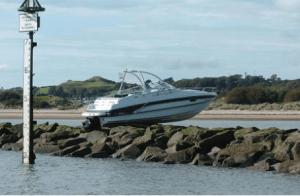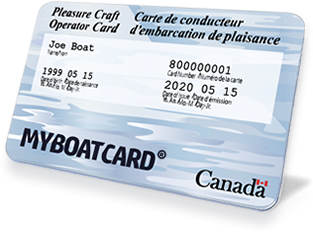Emergency: Capsizing, Swamping, Sinking or Grounding
The following actions should always be taken in the event that your craft should capsize, swamp, run aground, sink, or if you are involved in a collision:
- Ensure that everyone on board is wearing a PFD or a lifejacket;
- Stay with the craft when it is appropriate to do so;
- Check that all on board are accounted for and safe; and
- Use or exhibit signals to indicate distress and need of assistance as necessary.
Capsizing
 Capsizing and falling overboard are the leading causes of boating fatalities. Overloading, shifting of loads, and passenger movement on smaller craft contribute to most of the capsizing/falls overboard accidents.
Capsizing and falling overboard are the leading causes of boating fatalities. Overloading, shifting of loads, and passenger movement on smaller craft contribute to most of the capsizing/falls overboard accidents.
Boat operators must take action to prevent themselves and others on board from falling overboard.
If your boat capsizes but is in no danger of sinking, climb onto the overturned hull and signal for assistance.
Removing yourself from the water will prolong your survival time in cold water and make you more visible to potential rescuers. Do not leave a floating vessel to swim to shore; the shore is always more difficult to reach than it appears.
for help (do not swim to shore).
Grounding
 To free a vessel that has run aground, it may be necessary to move crew and equipment to one side to make the boat heel over.
To free a vessel that has run aground, it may be necessary to move crew and equipment to one side to make the boat heel over.
The boat may have to be lightened by moving equipment and people to another boat. If the boat is small, it may be possible for crew members in the water to push the boat off.
Take the following action if you are operating a powered pleasure craft and it runs aground:
- Stop the engine to assess the situation and check to see if anyone on board is injured;
- If anyone is injured, call for assistance on VHF radio or cellular phone;
- If there are no injuries and you are not in immediate danger, assess the situation and check for any damage to your boat’s hull, and for leaks or flooding;
- If yes – call for help as you may need to be towed to shore;
- If there is no damage or signs of leaks or flooding, try to get your boat loose;
- Shift the weight farthest away from point of impact/grounding;
- Try to shove off from the bottom, rock or shoal;
- If you cannot get loose or refloat, call for help on marine VHF radio or issue a distress call if necessary and consider a tow;
- Ensure everyone on board is wearing a lifejacket or PFD; and
- If grounded on a reef or uncertain location, it may be prudent to stay grounded until help arrives.
vessel are in danger.

